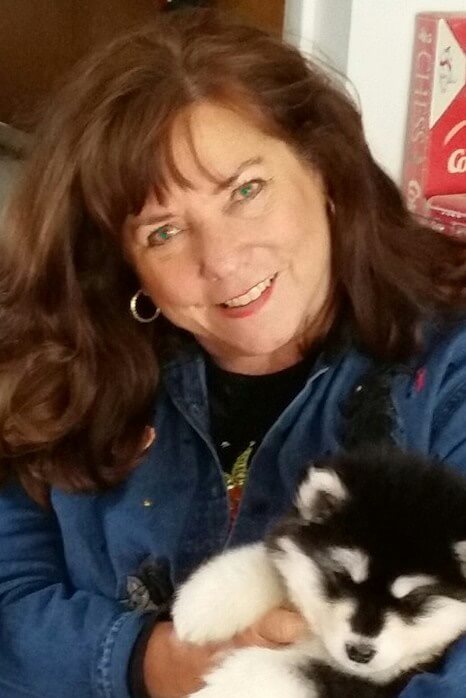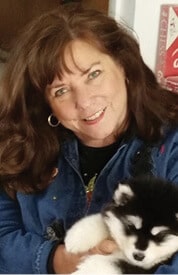


Home » Insights from Working Group Judge Anne Marie Taylor

Interview with Working Group Judge Anne Marie Taylor
Where do I live? How many years in dogs? How many years as a judge?
Anne Marie Taylor: We sold our kennel in Fenton, Michigan, in 2010 and moved into a subdivision in Grand Blanc, Michigan. My dad was third generation raised on a cattle ranch with large dogs such as Mastiffs, Chesapeake Bay Retriever, Labs, etc. So, I grew up with large dogs, albeit mixed breeds from the Humane Society. In 1974, Jim came home one day after teaching 4-H Obedience and told me that he bought an AKC Registered Akita. I didn’t know what it was. I thought he’d bought me one of those cute, tiny, white dogs with the long hair… Maltese. LOL! NOT! I’ve been judging since 1999.
What is my original breed? What is/was my kennel name?
Anne Marie Taylor: Akitas were our original breed. We’ve had Alaskan Malamutes interjected throughout the years. Tora Akitas is our kennel name, after our first Akita.
Can I list a few of the notable dogs I’ve bred? Any performance or parent club titles?
Anne Marie Taylor: Our foundation bitch, Am./Can. CH Tora’s Michiko O Ryan TT, ROMPX, is still tied for producing the most AKC champions. “Michiko” was bred by Rita J Biddle, Esq. BIS Am./Can. CH Momo Saku ROMP was the #1 Akita Bitch in 1995/1996 and #4 overall. Am./Can. CH Tora’s Yuri was the #1 Akita Bitch in 1993/94. BISS Am./Can. CH We Missed Miss Saigon and Am./Can. CH Tora’s Hyoga Hazumi are also notable. We’ve had generations of Register of Merit Akitas.
What are the qualities I most admire in the Working breeds?
Anne Marie Taylor: Our Alaskan Malamute, Grand Champion Sno Klassic Poker Flat E Street Shuffle, “Clarence,” didn’t like my walker after my back surgery. I actually had a terrible fall the day I got home. Clarence rushed to the rescue before Jim and Chris, our son, could get to me. Clarence burrowed under me and, once I got a hold of his ruff, he stood me up. From that day on, he volunteered to act as my walker. We placed him in a harness. No training needed, just care and compassion for his owner. He was always mindful, never pulling, always gentle—the perfect example of a strong, caring, Working Dog.
Have I judged any Working Group Specialties?
Anne Marie Taylor: Yes, I’ve judged the Akita Pre-National Specialty, American Akita National Specialty in Moscow, the first AKC Leonberger National Specialty, and the Alaskan Malamute, Greater Swiss, Newfoundland, Kuvasz, St. Bernard, Siberian Husky, Samoyed, Great Dane, and Neapolitan Mastiffs Specialties, just to name a few.
Do I find that size, proportion, and substance are correct in most Working breeds?
Anne Marie Taylor: Overall, I am satisfied. I think that the standards are specific enough in regard to size/height. There are obvious standouts with correct proportion and substance. I think that proportion seems to be the hardest for the breeders to breed to. It’s a matter of math. If the proportions should be 9:10 and the dog is 27 inches tall… 9×3=27 (inches tall), thus the length should be 10×3=30 (inches long). When I tell an Akita breeder that their 27-inch Akita should be 30 inches long, many are shocked… and discussion, pictures, and measurements ensue!
Is breed-specific presentation important to me as a judge? Can I offer some examples?
Anne Marie Taylor: Yes. I know that Jim referred to the presentation in regards to movement, so I’m going to go a different way. I am going to refer to grooming and condition. I had a discussion with one of my old breeder friends many years ago. He expressed that it takes him weeks/months to get a “dog” into “Show Dog” condition. He was referring to the muscle tone, stamina, coat condition, nails, and clean teeth, etc. I remember being at a show many years ago when several Kuvaszok came to the ring right out of the field. Their coats were brown with dirt and sticks, nails long and curled. Today, you would NEVER see such a sight! We spoke to those exhibitors. They thought it was perfectly acceptable for a “working dog” to present at a dog show in their working state. I kind of laughed and tried to explain what my grandpa always said: “When showing cattle or horses at a show or parade, they should be cleaned up like they were going to church!”
What are my thoughts on cropping/docking the Working breeds?
Anne Marie Taylor: I respect the parent clubs’ reasoning on whether to crop/dock. I understand why they wish it. I also respect the various countries that have decided to ban the practice. I was lucky to own and show breeds where it is not an issue; Akitas and Alaskan Malamutes.
Are the Working breeds in good shape overall? Any concerns?
Anne Marie Taylor: I think that most of the Working breeds are in pretty good shape. I can actually say that Akitas and Great Danes have improved greatly since I started judging.
I am concerned with a few of the Mastiff breeds. Somehow, the belief has evolved that a head is more important to a dog than being sound. A crippled dog is NEVER good for a breed; I don’t care how wonderful their head is. Breeders must educate themselves on hip dysplasia and luxating patellas, and I’m seeing hyper-extended hocks return to the ring.
My recent concern is temperament. With all of the COVID cancellations, exhibitors became complacent with the socialization of their Working Dogs. I hear it over and over, “Ugh! he’s a COVID puppy.” It is NOT OKAY to expect that their dog’s bad behavior and lack of training is acceptable. I disqualified a 24-month-old dog for the first time ever for biting—not me, but its handler—this past summer. Working Dogs have strong personalities and MUST be socialized!
With all of the COVID cancellations, exhibitors became complacent with the socialization of their Working Dogs. I hear it over and over, “Ugh! he’s a COVID puppy.” It is NOT OKAY to expect that their dog’s bad behavior and lack of training is acceptable.
In my opinion, how do today’s exhibits compare with the Working Dogs of the past?
Anne Marie Taylor: It’s funny. We talk about the all-time best dogs in conversations, but when I look back at many of their pictures, they aren’t always as pretty and as perfect as I remember. Thus, I think that breeders are much more educated now, and knowledge is so much more readily available, that we have better looking and healthier dogs now.
Why do I think the Working breeds are so admired as family companions?
Anne Marie Taylor: They are smart, companionable, loyal, and sturdy.
Just for laughs, do I have a funny story I can share about my experiences judging the Working Group?
Anne Marie Taylor: When I was showing dogs, I was very aware that my shoes should be functional—and then, pretty. But as a judge, I was trying to look elegant like Michele Billings and wear cute slip-on shoes. (Okay, I’ve never been accused of being elegant. LOL!) So, I was judging a show in the pouring down rain with my new cute slip-on shoes… in ankle deep mud! All of a sudden, I LOST my shoe in the mud. Of course, it was funny. That’s what I got for pretending to be elegant! So, when you see me wearing knee-high boots in the mud, you’ll know why!
